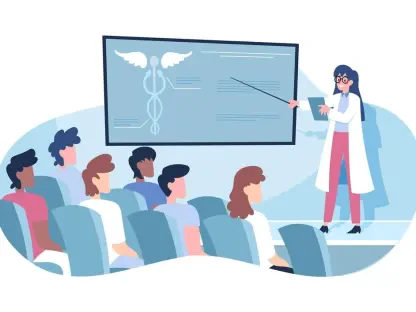The healthcare sector is undergoing a significant transformation as its organizations increasingly face intense scrutiny from federal audit bodies, particularly those linked to Medicare and Medicaid. This new era of healthcare audits prompts hospitals, clinics, and care facilities to re-evaluate their compliance strategies to mitigate potential risks. Financial sustenance and reputability now hinge on proactive measures, making it imperative to stay ahead of audit triggers. Basil Casteleyn, an authority on healthcare audits, emphasizes the urgency of adapting to this evolving landscape. Casteleyn’s insights shed light on common red flags in healthcare practices and offer practical strategies to help institutions navigate these heightened audit environments confidently. In a climate where stringent compliance with federal guidelines is non-negotiable, understanding the mechanics of preemptive and proactive compliance becomes crucial. Enhancing audit readiness, fostering operational adherence, and leveraging advanced technology are not just recommendations but essential doctrines for modern healthcare management to uphold accountability and fiscal health.
Identifying Financial Anomalies
Financial anomalies, often overlooked in routine operations, are frequent precursors to significant audits. Inconsistencies in billing practices, such as frequent billing code errors and unusually high reimbursement rates for specific procedures, catch the eye of audit agencies like CMS and OIG. These entities use sophisticated comparative analytics to benchmark providers against industry averages, rapidly spotting deviations that signal noncompliance. Basil Casteleyn underscores the importance of self-identifying and rectifying these financial irregularities. By instituting robust auditing mechanisms internally, healthcare providers can identify and correct deviations before they attract unwelcome attention. Implementing routine financial assessments not only mitigates risk but also reinforces fiscal responsibility. Such preemptive audits allow healthcare entities to streamline operations, ensuring billing precision. Further advantages involve fostering an environment of transparency that enhances the organization’s trustworthiness and reliability, essential components for stability in today’s healthcare sector.
Moreover, financial preparedness underpins robust audit defenses. To ward off invasive audits, healthcare organizations must integrate self-auditing tools capable of detecting and elucidating complex billing arrangements. This alignment guarantees that financial records are not merely accurate but churned through a refined process that ensures the highest level of scrutiny. Tailoring financial analyses to expose potential areas of vulnerability is another strategic cornerstone in establishing an effective defense against audits. Casteleyn advises leveraging financial analytics not just for current preparedness but to project future compliance landscapes, allowing organizations to adapt to new regulatory changes dynamically. These internal practices contribute to a sustainable compliance culture, securing an institution’s fiscal integrity and positioning it favorably against potential audits.
Operational Gaps and Compliance Alignment
Beyond financial discrepancies, operational gaps within healthcare workflows are critical indicators of potential compliance breaches. Missing or inaccurate documentation in electronic health records, lack of proper patient consent forms, and inconsistencies in patient scheduling and referrals serve as glaring signals requiring immediate attention. These lapses often suggest deeper compliance issues that could attract regulatory scrutiny. Basil Casteleyn underlines the importance of closing these operational gaps by ensuring alignment between administrative workflow and clinical precision standards. By adhering strictly to detailed process documentation and regularly updating compliance protocols, healthcare organizations can significantly reduce the likelihood of audits. This alignment must extend to training staff across various departments, such as administrative, billing, and clinical sectors, creating cohesive synergy for seamless compliance.
Cross-departmental collaboration plays a potent role in fortifying operational alignment. Organizations should create mechanisms that enable departments to interact and share vital data consistently, facilitating transparent workflows that minimize errors. Establishing rigorous documentation practices fortifies the process integrity, ensuring that every action taken within an organization is accounted for with precision and accountability. This proactive stance in compliance management provides an essential safeguard, shielding organizations from often costly and disruptive audits. Casteleyn asserts that by reinforcing operational compliance through continuous training, healthcare providers are well-equipped to anticipate and neutralize potential compliance disruptions. These foundational steps ensure that organizations are not only remedying existing operational gaps but remain resilient as they navigate the inevitable complexities of the healthcare audit landscape.
The Proactive Compliance Model
Basil Casteleyn argues that many healthcare organizations mistakenly adopt a reactive compliance approach, only addressing issues after audits have been triggered. This strategy often results in disordered management responses, legal exposure, and a chaotic rush to correct errors under pressure. Instead, a proactive compliance model is the safeguard against these pitfalls, embedding compliance management into the organization’s basic framework. Proactive compliance involves regular internal audits, ongoing staff training, and the incorporation of compliance intelligence as a staple of everyday operations. By catching potential compliance missteps early, organizations can refine their processes ahead of audits, maintaining regulatory excellence and mitigating unforeseen risks.
Internal controls form the backbone of proactive compliance. With routine audits, institutions can foster an environment where compliance standards become ingrained in their operational DNA. Maintaining updated policies and ensuring that employees are informed of compliance changes through continuous training fosters a culture of compliance that withstands audit pressures. Implementing these structures not only aids in adhering to federal regulations but also strengthens the governance framework, encouraging sustainable practices across the organization. As Basil Casteleyn points out, embedding compliance into the core ethos of healthcare entities helps prevent audit triggers, ensuring operations run smoothly and efficiently, without the looming threat of financial and reputational harm.
Technological Integration in Compliance
Advancements in technology present powerful opportunities for healthcare providers to streamline compliance and fend off potential audits effectively. Incorporating AI and analytics tools allows organizations to monitor data trends, identify outliers, and simulate audit scenarios, exposing areas of vulnerability before they escalate into significant issues. Automation serves as a pivotal line of defense, enhancing transparency and shielding providers from noncompliance. Real-time reporting dashboards and predictive modeling enable continuous evaluation of high-risk claims, ensuring billing accuracy and documentation integrity, helping to address potential compliance concerns proactively.
Technological tools also provide a framework for efficient data management and analysis, enabling comprehensive assessments that are critical for audit preparedness. By automating repetitive tasks and adopting AI-driven analytics, healthcare providers not only improve operational efficiency but significantly reduce the scope for human error. Basil Casteleyn advocates for the integration of cutting-edge technologies, arguing that they streamline the auditing process while allowing organizations to focus on providing quality care. By creating predictive models specific to an organization’s historical data, providers can anticipate potential compliance challenges, delivering insights that inform decision-making processes and advance organizational goals. Strategic use of technology thus becomes an indispensable ally in navigating the challenging landscape of healthcare audits.
Strengthening Staff Education and Readiness
Staff education and internal controls are integral to minimizing the risk of audit triggers, as human errors stemming from inconsistent training and weak internal policies can inadvertently set off red flags. Regular training programs, policy assessments, and audit simulations ensure that staff members are well-informed and equipped to uphold compliance standards effectively. A unified approach across departments—with personnel trained in compliance fundamentals and updated on industry shifts—helps reduce the risk of inadvertent noncompliance. Additionally, establishing clear reporting pathways and encouraging whistleblower protections cultivate a culture of ethical responsibility among employees, fostering transparency and organizational integrity.
An emphasis on continuous staff development ensures teams are prepared to deal with the complexities of compliance. By investing in education, healthcare organizations promote a supportive environment where employees are encouraged to engage with compliance protocols actively. Audit simulation exercises help staff comprehend the audit process, preparing them to respond adeptly when actual audits occur. With employees aligned in their roles, organizations can safeguard against compliance missteps, and any irregularities can be swiftly detected and rectified. Basil Casteleyn emphasizes the importance of constructing strong internal controls, as they form the foundation upon which robust compliance structures are built, promoting lasting operational excellence within the healthcare sector.
Audit Preparedness and Strategic Actions
Despite diligent efforts to prevent audits, being prepared for them is essential. Healthcare entities equipped with comprehensive documentation, strong internal review mechanisms, and a documented history of compliance are better positioned to navigate audits favorably. Casteleyn equips organizations with audit defense playbooks, detailing step-by-step procedures like communication protocols, evidence collection, and legal documentation commencement upon audit notification. Meticulous preparation reassures regulators, shortens audit processes, and protects an organization’s financial integrity, reducing the disruption audits can cause.
Preparing for audits involves not just having documentation in order but also creating a structured response plan to address audit demands efficiently. Basil Casteleyn’s approach to audit defense playbooks instills confidence, ensuring organizations can tackle audits with precision and preparedness. Reliable audit preparation demonstrates to regulators a commitment to compliance, ultimately facilitating smoother interactions. This readiness not only mitigates potential financial liabilities but also safeguards an organization’s reputation. In a world where audits are constant threats, preparedness is key to maintaining operational harmony and resilience, equipping healthcare organizations with the tools necessary to withstand regulatory examinations with confidence and assurance.
A Proactive Approach to Navigating Audits
The healthcare industry is experiencing a major transformation as it confronts heightened scrutiny from federal audit agencies, especially those associated with Medicare and Medicaid. This wave of healthcare audits is compelling hospitals, clinics, and care facilities to reassess their compliance plans to limit potential risks. Financial stability and reputability now depend on proactive strategies to avoid audit triggers. Basil Casteleyn, a specialist in healthcare audits, highlights the urgent need to adapt to this changing landscape. He provides insights into common warning signs in healthcare operations and offers practical strategies to help institutions confidently navigate through these rigorous audit conditions. In this environment, where strict compliance with federal regulations is mandatory, understanding the mechanics of proactive compliance is essential. Boosting audit readiness, fostering operational compliance, and using advanced technologies have become fundamental tenets for modern healthcare managers aiming to uphold accountability and financial health.









